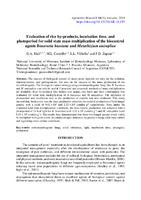Evaluation of rice by-products, incubation time, and photoperiod for solid state mass multiplication of the biocontrol agents Beauveria bassiana and Metarhizium anisopliae
Date
2018-08-01Author
Bich, Gustavo Ángel
Castrillo, María Lorena
Villalba, Laura Lidia
Zapata, Pedro Darío
Metadata
Show full item recordAbstract
The success of biological control of insect pests depends not only on the isolation, characterization, and pathogenicity, but also on the success of the mass production of the microbial agents. The biological control strategy using entomopathogenic fungi like B. bassiana and M. anisopliae can only be useful if practical and economic methods of mass multiplication are available. Rice by-products like broken rice grains, rice hulls and their combination was evaluated for solid state multiplication of B. bassiana and M. anisopliae. The influence of photoperiod and incubation time in the production of conidia was also evaluated. This study showed that, broken rice was the most productive substrate for conidial production of both fungal genera, with a yield of 4.62 x 107 and 2.22 x 106 conidia g-1 respectively. Also, under the evaluated solid state multiplication conditions, the best conidia production was achieved with a photoperiod of 24 h of light for B. bassiana (with 4.43 x 107 conidia g-1) and M. anisopliae (with 1.35 x 106 conidia g-1). The results here demonstrated that these two fungal species could viably be multiplied with good yields of conidia on agro-industrial by-products using solid-state culture and regulating some culture conditions.
Collections
The following license files are associated with this item:




